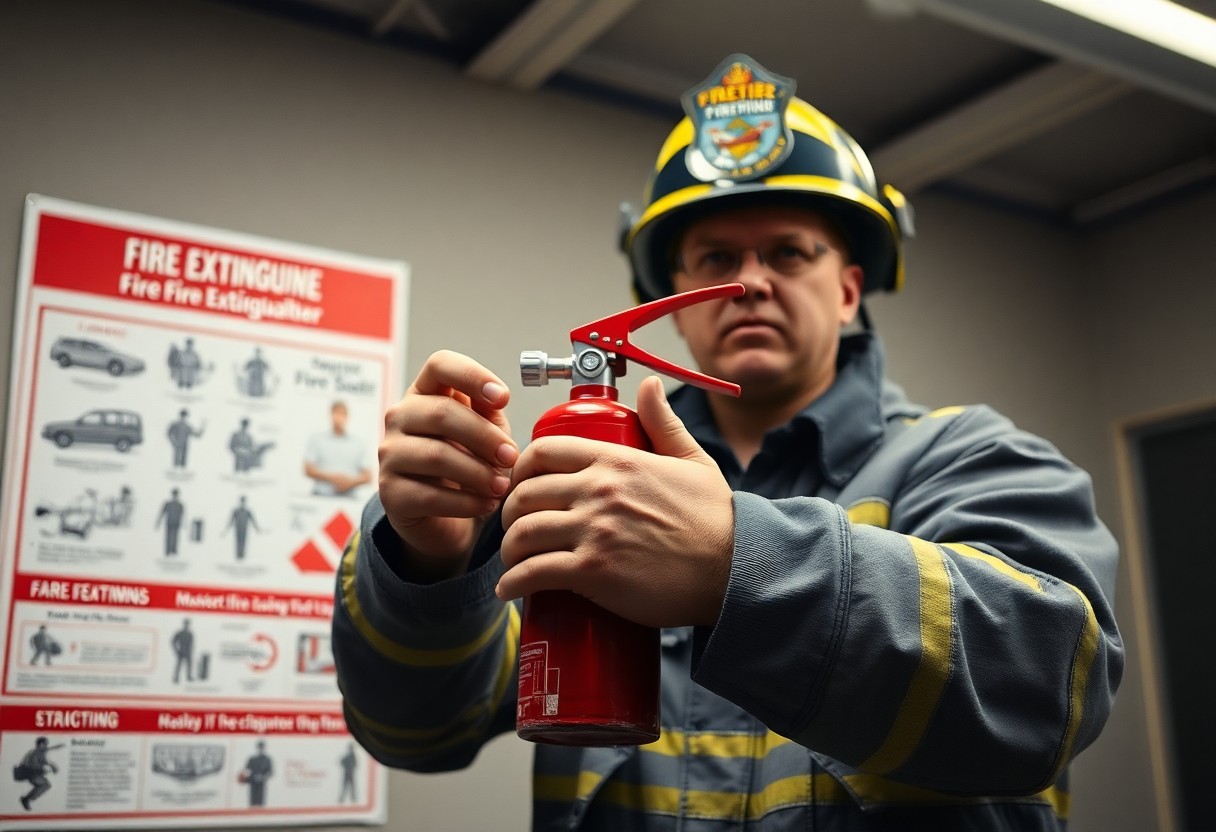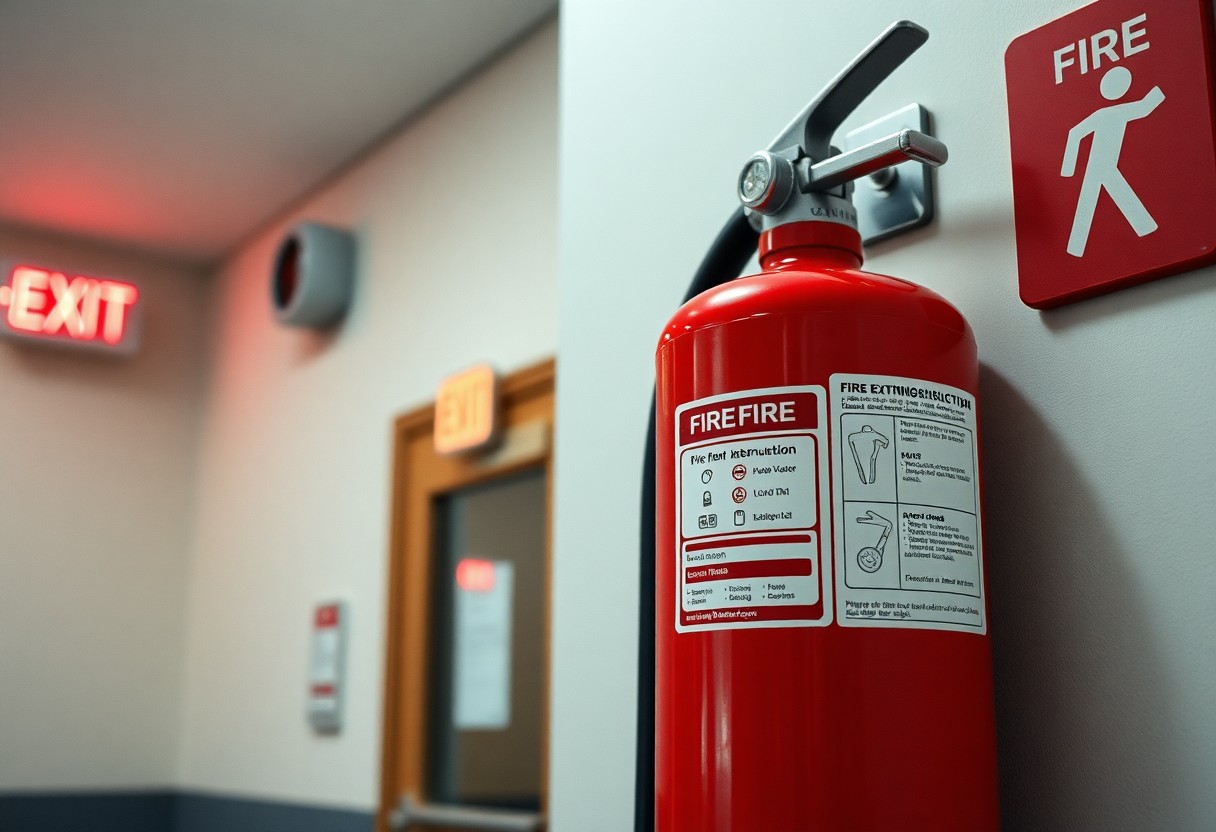It’s imperative that you understand how to use fire extinguishers effectively, as they can be lifesaving tools in emergency situations. Knowing the difference between the various types of extinguishers and the correct methods for operating them can greatly enhance your safety and that of others. This guide will equip you with the knowledge needed to tackle small fires confidently, ensuring you can act swiftly and efficiently when it matters most. Stay safe and be prepared by understanding your role in fire safety.
Key Takeaways:
- Familiarize yourself with the different types of fire extinguishers and their specific uses.
- Follow the PASS technique: Pull the pin, Aim at the base, Squeeze the handle, Sweep side to side.
- Regularly check the extinguisher for proper maintenance and accessibility in case of an emergency.
Understanding Fire Extinguishers
Fire extinguishers are vital safety devices designed to combat various types of fires effectively. You must understand their classifications and uses to respond effectively in an emergency. Each extinguisher is specifically tailored to tackle different fire categories, helping prevent further damage and ensuring your safety.
Types of Fire Extinguishers
- Water Extinguishers: Effective on Class A fires involving solid combustibles.
- Foam Extinguishers: Suitable for Class A and B fires involving liquids.
- Dusting Extinguishers: Tackles electrical fires without conductive risk.
- CO2 Extinguishers: Ideal for Class B and C fires, particularly involving electrical equipment.
- Dry Powder Extinguishers: Versatile for Class A, B, and C fires, effective against various fuels.
After familiarizing yourself with these types, choosing the right one for your environment becomes easier.
| Type | Use |
| Water | Solid materials |
| Foam | Flammable liquids |
| CO2 | Electrical fires |
| Dry Powder | Multiple classes |
| Wet Chemical | Kitchen fires |
How Fire Extinguishers Work
Fire extinguishers operate by disrupting the fire triangle: heat, fuel, and oxygen. By removing one of these elements, the fire cannot continue burning. Understanding this mechanism allows you to choose the appropriate extinguisher for each situation, maximizing your ability to extinguish flames safely and effectively.
For instance, a water extinguisher cools the fire, lowering the temperature below its ignition point. Carbon dioxide extinguishers displace oxygen, effectively suffocating the fire. Each type has a specific application based on the materials involved in the fire. Thus, knowing your fire’s source assists in selecting the right extinguisher, ensuring effective application and promoting safety in fire emergencies.
Identifying Fire Classes
To effectively combat a fire, it’s crucial to identify its class. Fires fall into specific categories based on the materials involved, each requiring different extinguishing methods. Understanding these classes allows you to select the appropriate fire extinguisher and act decisively in an emergency.
Class A Fires
Class A fires involve ordinary combustible materials, such as wood, paper, and textiles. These fires are common in residential and commercial settings, making it important for you to know how to extinguish them effectively.
Class B Fires
Class B fires are fueled by flammable liquids, including gasoline, oil, and solvents. When dealing with these fires, you should use extinguishers specifically rated for Class B to avoid spreading the flames.
Class B fires can escalate quickly, often spreading rapidly across surfaces due to the nature of the flammable liquids involved. It’s crucial to act promptly and precisely, using extinguishers marked with a “B” while ensuring you’re positioned upwind of the fire, as vapors can ignite easily.
Class C Fires
Class C fires occur with energized electrical equipment, such as wires, appliances, or motors. In these situations, using water-based extinguishers can lead to electrocution, making it vital to use only those rated for Class C fires.
Ensure you’re familiar with the location of Class C extinguishers, which often utilize dry chemical or CO2 to suppress electrical fires safely. Always disconnect the power source if it’s safe to do so before applying an extinguisher, as this prevents re-ignition and increases your safety.
Class K Fires
Class K fires are primarily associated with cooking oils and greases, common in commercial kitchens. Using the wrong extinguisher on these fires can result in a dangerous flare-up.
Class K extinguishers are specifically designed to combat these types of fires by cooling the flames and creating a barrier between the oil and oxygen. It’s critical to locate these extinguishers in or near kitchen areas, allowing for quick access during an emergency, as their unique properties slow the combustion process effectively.

Selecting the Right Fire Extinguisher
To effectively manage fire risks, you must select the right fire extinguisher for your environment. Different types extinguish different classes of fires, such as Class A for ordinary combustibles, Class B for flammable liquids, and Class C for electrical fires. For comprehensive guidelines, take the time to review Fire Extinguishers Use and Inspection to understand the unique requirements for your setting.
Assessing Fire Risks
Evaluating fire risks in your area is important for choosing the appropriate fire extinguisher. Analyze potential hazards based on your activities, materials, and equipment. For instance, kitchens present different risks compared to industrial settings. Identify sources of ignition and fuel to tailor safety measures effectively.
Choosing the Appropriate Extinguisher
The appropriate extinguisher depends on the fire risks you’ve identified. Opt for multipurpose extinguishers, like ABC extinguishers, for versatility across various fire classes. If you’re frequently dealing with specific materials, consider specialized extinguishers designed for those risks, such as foam extinguishers for flammable liquids.
When choosing the appropriate extinguisher, think about not just the types of fires that could occur, but also accessibility and ease of use. Ensure the extinguisher is easy to handle, particularly in stressful situations. Maintain it according to manufacturer guidelines to guarantee it functions properly when you need it most. Familiarize yourself with its operation to increase your response confidence during an emergency.
Proper Use of Fire Extinguishers
Using a fire extinguisher effectively can make a significant difference in stopping a small fire before it escalates. First, you must assess the situation and ensure the fire is manageable. Stand at a safe distance, and remember to always have an escape route in mind. Choosing the right type of extinguisher for the specific fire class is also vital, as using the wrong one can worsen the situation. When you’re ready to act, follow the PASS method to ensure you extinguish the fire efficiently.
The PASS Technique
The PASS technique is a simple, four-step process for using fire extinguishers effectively: Pull the pin, Aim the nozzle at the base of the fire, Squeeze the handle, and Sweep the nozzle from side to side. Position yourself about six to eight feet away from the flames, and remember, the goal is to target the fuel, not the flames themselves. This method maximizes your chances of extinguishing the fire quickly and safely.
Common Mistakes to Avoid
Many people make mistakes when using fire extinguishers, which can lead to dangerous situations. For instance, not pulling the pin properly can hinder the operation, or aiming at the flames instead of the base can reduce effectiveness. Additionally, standing too close can expose you to dangerous heat and fumes. Overlooking the need for an evacuation route is another critical error; always prioritize your safety above all else.
Neglecting maintenance of extinguishers is another common oversight; you should check pressure gauges regularly to ensure functionality. Failing to familiarize yourself with the location and operation of your fire extinguisher can lead to panic during an emergency. Also, don’t be tempted to use water on grease or electrical fires, as this can create hazardous spray and worsen the blaze. Practice using the PASS technique to build confidence before a real emergency arises, ensuring you can act quickly and effectively.
Maintenance and Inspection
Regular maintenance and inspection of fire extinguishers are crucial to ensure they function effectively when needed. This includes verifying that they are easily accessible, properly charged, and free from any physical damage. Conducting scheduled inspections helps identify potential issues that could hinder performance, ultimately protecting lives and property.
Routine Checks
Perform routine checks on your fire extinguishers monthly. Look for signs of damage, proper pressure levels indicated by the gauge, and ensure the safety pin is intact. Additionally, check that the extinguisher is in the correct location and easy to access. Keeping a log of these checks can help track maintenance records.
When to Replace
Fire extinguishers must be replaced if they show significant wear and tear, have a damaged gauge, or are older than their recommended lifespan. Typically, extinguishers should be replaced every 5 to 15 years, depending on the type. Always refer to manufacturer guidelines for specifics.
When considering replacement, it’s vital to note certain signs that indicate an extinguisher has reached the end of its life. If the pressure gauge is in the red zone, the nozzle is clogged or damaged, or inspection tags indicate it’s overdue for service, you should replace it immediately. You can also check for corrosion, rust, or any leakage, as these can compromise the extinguisher’s effectiveness. In the event of any doubt about its condition, opting for a new unit is the safest choice.
Fire Safety Training
Fire safety training equips you with the skills needed to respond effectively in emergency situations. Engaging in regular drills and simulations enhances your preparedness, allowing you to act decisively during a fire incident. Understanding the various types of fires and the appropriate extinguishing methods is necessary for safety, ensuring you can protect yourself and others around you.
Importance of Regular Training
Participating in regular training sessions increases your confidence and ability to tackle fire emergencies. Consistent practice keeps vital information fresh in your mind, enabling you to react swiftly and correctly when every second counts. Training also cultivates a culture of safety within your organization, ensuring everyone is aligned in their responsibilities during a fire incident.
Resources for Training
You can access numerous resources for fire safety training, including local fire departments, the National Fire Protection Association (NFPA), and online courses. Many organizations offer tailored programs to meet your specific needs, whether you’re in a corporate setting or a residential environment. Utilizing these resources ensures you have the latest information and techniques required for effective fire response.
Local fire departments often provide hands-on training sessions that involve real-life scenarios, giving you practical experience. The NFPA offers comprehensive guides and materials tailored to different environments, from schools to offices. Online platforms like OSHA and other safety organizations also feature courses that facilitate self-paced learning, making it easy to fit training into your schedule. Consider utilizing simulations and fire drills to enhance your preparedness further, reinforcing knowledge through practice.
Conclusion
So, understanding how to use fire extinguishers can significantly impact your safety and the safety of those around you. Familiarize yourself with the types of extinguishers, how to operate them properly, and the importance of regularly checking their condition. By being prepared and knowledgeable, you not only protect yourself but also empower others to act effectively in an emergency situation, ensuring a safer environment for everyone.
FAQ
Q: What types of fire extinguishers are there?
A: There are five main types of fire extinguishers: Class A (for ordinary combustibles like wood and paper), Class B (for flammable liquids and gases), Class C (for electrical fires), Class D (for combustible metals), and Class K (for cooking oils and greases).
Q: How do I use a fire extinguisher?
A: Use the PASS technique: Pull the pin to unlock the extinguisher, Aim the nozzle at the base of the fire, Squeeze the handle to discharge the extinguishing agent, and Sweep the nozzle side to side until the fire is out.
Q: When should I use a fire extinguisher?
A: Use a fire extinguisher when the fire is small and contained, if you are trained to use it, you have a clear escape route, and the room is not filled with smoke.
